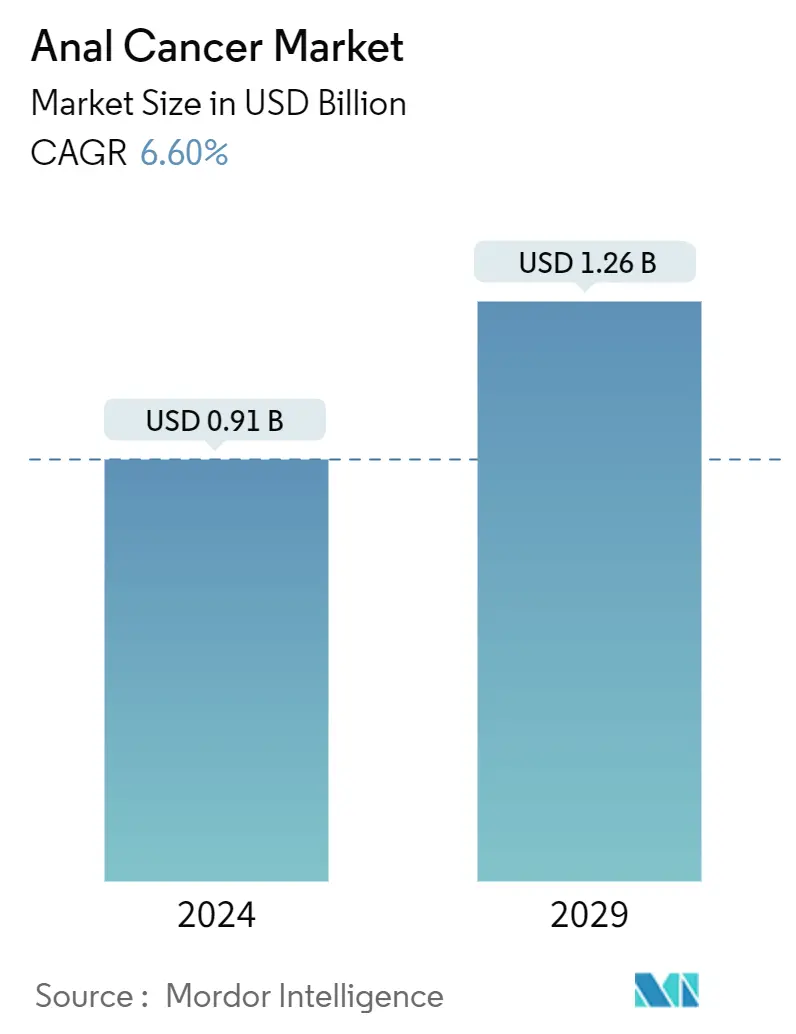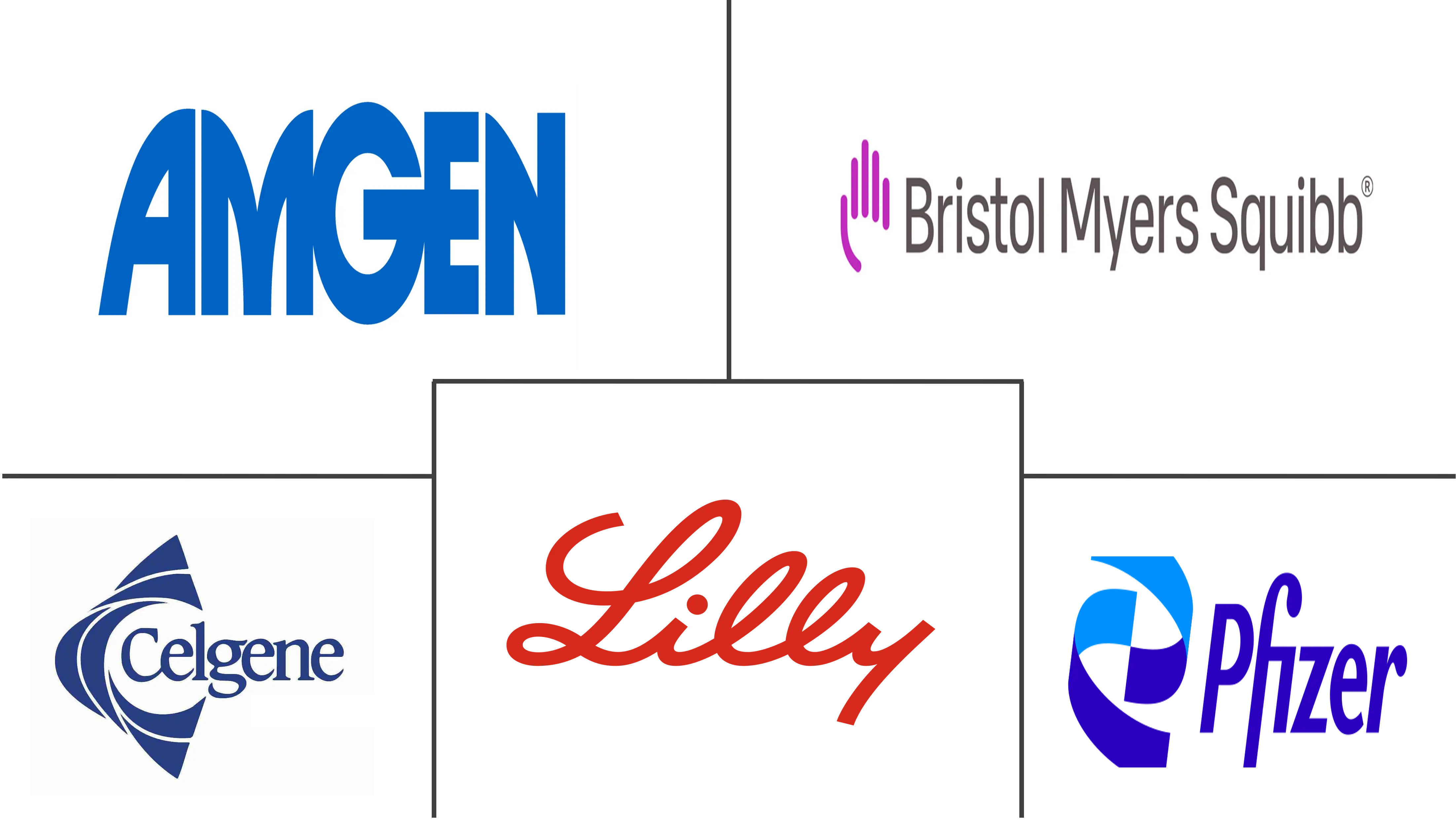Market Size of Anal Cancer Industry

| Study Period | 2018-2029 |
| Market Size (2024) | USD 0.91 Billion |
| Market Size (2029) | USD 1.26 Billion |
| CAGR (2024 - 2029) | 6.60 % |
| Fastest Growing Market | Asia Pacific |
| Largest Market | North America |
| Market Concentration | Medium |
Major Players
*Disclaimer: Major Players sorted in no particular order |
Anal Cancer Market Analysis
The Anal Cancer Market size is estimated at USD 0.91 billion in 2024, and is expected to reach USD 1.26 billion by 2029, growing at a CAGR of 6.60% during the forecast period (2024-2029).
The COVID-19 pandemic influenced the anal cancer market through supply chain disruptions that hindered the manufacture and distribution of medical products required for anal cancer treatment. Due to the global pandemic, the healthcare staff put more effort into combating the infections, and other medical procedures and cancer screening were declined. For instance, in August 2023, an article published in the eClinical Medicine Journal estimated that COVID-19-related screening resulted in the loss of around 7.4 million lower fecal screenings in colorectal cancer during the beginning of the pandemic. Thus, the decline in anal cancer screening affected the diagnosis and treatment of anal cancer, hence impacted the market during the pandemic. There was a significant risk of anal cancer in individuals with COVID-19 infection and other cancers. Thus, due to the high risk of anal cancer development and progression with COVID-19 infection and other comorbidities contributed to the market growth.
Various factors, such as the incidence of anal cancer, the increase in the prevalence of sexually transmitted diseases and anal cancer, and the rise in research and development activities, will lead to market growth during the forecast period.
The increase in the incidence of anal cancer and the prevalence of sexually transmitted infections and anal cancer is the primary factor influencing the market growth. Anal cancer is caused by the human papillomavirus due to skin-to-skin contact of the genital organs, resulting in a sexually transmitted disease. For instance, Cancer Research UK published statistics reported that anal cancer incidence rates are projected to grow by 14% in the United Kingdom between 2023-2025 and 2038-2040, and there are approximately 2,400 new cases of anal cancer every year in the United Kingdom by 2038-2040. Additionally, anal cancer is predominantly found in females as compared with males. Thus, the growing incidence rate of anal cancer is a significant factor boosting the market growth over the forecast period.
Moreover, the increase in research and development activities for the production of effective treatments to treat anal cancer is contributing significantly to the market growth. For instance, in July 2022, the Anal Cancer Foundation published an Anal Cancer high-grade squamous intraepithelial lesion (HSIL) Outcomes Research (ANCHOR) study in the New England Journal of Medicine, represented that early detection and treatment of anal HSIL (anal precancer) can decrease disease progression by 57%. Additionally, the study found that the incidence rate of anal cancer was higher in the patients infected with the human immune-deficiency virus (HIV). Moreover, partnerships of research institutes promote the treatment development of anal cancer. For instance, in September 2023, the University of Cincinnati Cancer Center Research established a partnership with Ride Cincinnati (an organization involved in cancer research and care), which raised funding of USD 4 million for the treatment of patients with anal cancer and improving the quality of life of patients. Thus, increased research activities to determine the causes and effective treatments contributed to the market growth.
Hence, the increase in the prevalence of sexually transmitted infections will contribute to the rise in anal cancer cases, and the increase in research and development activities with significant funding are the major factors driving the market growth. However, the side effects of chemotherapy and the high cost of treatments may affect the market growth of anal cancer over the forecast period.
Anal Cancer Industry Segmentation
According to the scope, anal cancer is an abnormal growth of cells in or around the anus or anal canal.
The anal cancer market is segmented by cancer type (carcinoma in situ, squamous cell carcinoma, melanoma, adenocarcinoma, basal cell carcinoma, and other cancer types), treatment type (chemotherapy, surgery, radiation therapy, and immunotherapy), end-users (hospitals and clinics, research and academic institutes, and other end-users) and geography (North America, Europe, Asia-Pacific, the Middle East and Africa, and South America). The market report also covers the estimated market sizes and trends for 17 countries across major regions globally.
The report offers a value of USD for the above segments.
Anal Cancer Market Size Summary
The anal cancer market is poised for significant growth over the forecast period, driven by an increase in the incidence of anal cancer and the prevalence of sexually transmitted infections, particularly those linked to the human papillomavirus. The market's expansion is further supported by robust research and development activities aimed at producing effective treatments. The COVID-19 pandemic initially disrupted the market by affecting cancer screening and treatment processes, but it also highlighted the heightened risk of anal cancer in individuals with COVID-19 and other comorbidities, which has contributed to market growth. The chemotherapy segment is expected to play a pivotal role in market expansion, with treatments demonstrating promising results in reducing cancer cell counts and tumor progression. Clinical trials and studies continue to advance treatment options, with significant funding and partnerships enhancing research efforts.
North America leads the anal cancer market, driven by a growing burden of cases and active research initiatives. The region's market growth is bolstered by government support and collaborations aimed at developing new treatments. The market is moderately fragmented, with major players like Amgen Inc., Bristol Myers Squibb, and Eli Lilly and Company actively engaging in mergers, acquisitions, and new product launches to expand their portfolios. These companies are investing in advanced technologies to enhance production capabilities and address the evolving needs of the market. The ongoing clinical trials and collaborations, such as those involving monoclonal antibodies and biomarker-directed therapies, are expected to further propel market growth, as they aim to improve treatment outcomes and patient quality of life.
Anal Cancer Market Size - Table of Contents
-
1. MARKET DYNAMICS
-
1.1 Market Overview
-
1.2 Market Drivers
-
1.2.1 Increasing Prevalence of Sexually Transmitted Diseases and Anal Cancer
-
1.2.2 Increase in Research and Development
-
-
1.3 Market Restraints
-
1.3.1 Side Effects and High Cost of Treatment
-
-
1.4 Porter's Five Forces Analysis
-
1.4.1 Bargaining Power of Suppliers
-
1.4.2 Bargaining Power of Buyers/Consumers
-
1.4.3 Threat of New Entrants
-
1.4.4 Threat of Substitute Products
-
1.4.5 Intensity of Competitive Rivalry
-
-
-
2. MARKET SEGMENTATION (Market Size by Value - USD)
-
2.1 By Cancer Type
-
2.1.1 Carcinoma In-Situ
-
2.1.2 Squamous Cell Carcinoma
-
2.1.3 Melanoma
-
2.1.4 Adenocarcinoma
-
2.1.5 Basal Cell Carcinoma
-
2.1.6 Other Cancer Types
-
-
2.2 By Treatment Type
-
2.2.1 Chemotherapy
-
2.2.2 Surgery
-
2.2.3 Radiation Therapy
-
2.2.4 Immunotherapy
-
-
2.3 By End-User
-
2.3.1 Hospitals and Clinics
-
2.3.2 Research and Academic Institutes
-
2.3.3 Other End-Users
-
-
2.4 Geography
-
2.4.1 North America
-
2.4.1.1 United States
-
2.4.1.2 Canada
-
2.4.1.3 Mexico
-
-
2.4.2 Europe
-
2.4.2.1 Germany
-
2.4.2.2 United Kingdom
-
2.4.2.3 France
-
2.4.2.4 Italy
-
2.4.2.5 Spain
-
2.4.2.6 Rest of Europe
-
-
2.4.3 Asia-Pacific
-
2.4.3.1 China
-
2.4.3.2 Japan
-
2.4.3.3 India
-
2.4.3.4 Australia
-
2.4.3.5 South Korea
-
2.4.3.6 Rest of Asia-Pacific
-
-
2.4.4 Middle East and Africa
-
2.4.4.1 GCC
-
2.4.4.2 South Africa
-
2.4.4.3 Rest of Middle East and Africa
-
-
2.4.5 South America
-
2.4.5.1 Brazil
-
2.4.5.2 Argentina
-
2.4.5.3 Rest of South America
-
-
-
Anal Cancer Market Size FAQs
How big is the Anal Cancer Market?
The Anal Cancer Market size is expected to reach USD 0.91 billion in 2024 and grow at a CAGR of 6.60% to reach USD 1.26 billion by 2029.
What is the current Anal Cancer Market size?
In 2024, the Anal Cancer Market size is expected to reach USD 0.91 billion.

